By Frank Iannamico
Covert Ops Led to Experimental Smith & Wesson Model 76 Submachine Gun
During the 1961-1975 Vietnam War, the United States Navy had begun to procure submachine guns for use by its SEAL teams; a special operations force operating in-country. SEAL teams often used foreign submachine guns for their more covert operations for plausible deniability. Unhindered by any political, official standards or requirements for their proposed submachine guns to meet, the SEAL’s weapon of choice was the reliable and accurate 9mm m/45, Swedish K submachine gun. One of the Navy requirements for a submachine gun class weapon was the ability to drain water quickly from the receiver.
Problems with the military procurement of the Swedish submachine guns were eventually encountered due to Sweden’s long-standing position as a neutral country, along with their outspoken protest of U.S. involvement in the Vietnam War.
During the early spring of 1966, the U.S. Navy Department contacted Smith & Wesson representative Mr. George Ersham to inquire about the possibility of the U.S. company designing and manufacturing a weapon that would be similar in concept and operation to the Swedish K. By the fall of 1966, the Development Section of Smith & Wesson received an official written request from the Department of the Navy for the development of a new 9mm submachine gun. Corporation officials met with SEAL Team One at the Naval Amphibious Base Coronado, in San Diego, California, to discuss the project. During the meeting, Smith & Wesson officials were provided with a list of the characteristics desired in the proposed submachine gun. The rival Colt firearms company had the military market virtually sewn up at the time. Mr. Gunn recognized that a lucrative military order could help sustain his company’s future well into the 21st Century.
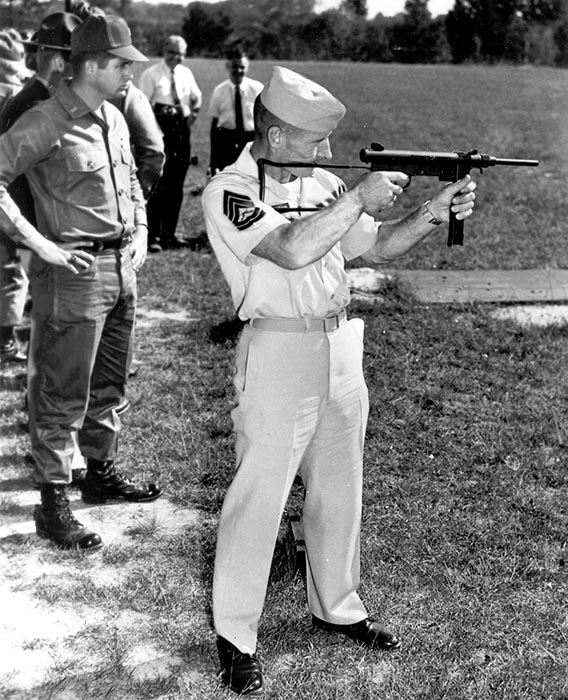
Mr. Dwayne Charron of the Research and Development Section of Smith & Wesson was chosen to head up the project. Mr. Charron was well qualified for the task, having a lot of experience with the development and design of many of the company’s firearms. The model designation assigned to the submachine gun project was the number 76. It was nothing other than a control number, having no other significance.
The X-Series Submachine Guns
Smith & Wesson routinely assigned a letter “X” prefix to experimental or preproduction projects. After a project had been developed and tested, blueprints were sent to the Engineering Department where final tolerances and dimensions were used to draw production blueprints. Firearms made from the prints were used to manufacture tool room models of the proposed gun. Those guns were designated with a letter “T” prefix for “Tool Room.” The letter “T” was occasionally used on a production weapon that had been modified.
The first experimental samples of the Model 76 were completed in the fall of 1966-1967 and were assigned serial numbers X-185 through X-219. The early X-185 gun lacked a buttstock and sights. On gun X-186, a folding stock and sights were added. Two X-prefixed guns, X-186 and X-219, were later modified for the caseless ammunition project. To make the weapon as light as possible, there was one prototype gun; X-188 was made with an aluminum alloy receiver. Later there was a request issued for nine additional aluminum receivers; these were serial numbered X-210 to X-218. Most of the receivers were not assembled into functioning weapons. Apparently, there were problems, and the aluminum receiver concept was abandoned.
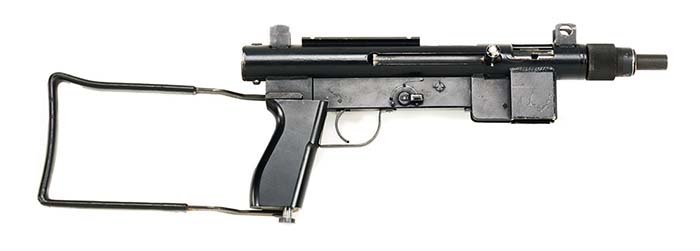

By January 1967, a prototype weapon was completed and ready for extensive field-testing. At this point the magazine for the 76 project had not been developed, so modified Swedish K magazines were used. Due to cost considerations, it was decided not to key the barrel for consistent indexing with the receiver. This saved a few machining processes to the barrel and receiver. The weapon that was designed by the engineers at Smith & Wesson looked somewhat similar to the Swedish submachine gun it was to replace, but there were a number of differences. Primarily, the Smith & Wesson submachine gun was lighter in weight, more ergonomic, slightly smaller in size, handier, featured a more positive safety, and it was select-fire.
The T-Series Submachine Guns
During May 1967, the first 10 Tool Room submachine gun models had been assembled. They were assigned serial numbers T-1111 to T-1120. During testing, a few failure-to-feed stoppages occurred. The problem was traced to an oversized magazine housing and was easily solved by inserting a U-shaped piece of steel to align and secure the magazine.
The X and T models of the M76 were fabricated in a number of configurations for testing and evaluation purposes.



The production of the first test lot of 100 guns commenced on June 24, 1968. Each gun had a four-digit serial number with a “T” prefix. The “T” prefix indicated that the guns were completed in the Research and Development Department’s Tool Room and not regular production pieces. The serial numbers of the early pre-production models were marked on the left side of the magazine well. The “T” series models were often configured differently. Most of the T series guns lacked the barrel jacket as seen on production guns. The method of securing the barrel to the receiver was different on guns that lacked a barrel jacket. A barrel retaining catch was utilized, similar to that of the U.S. M3 submachine gun. The strut arms of the early stocks were straight while the later production models curved around the back of the receiver tube. The sides of the plastic grip were smooth. A total of 105 T prefix weapons were built by the Research and Development Department from November 1966 to April 1971. Most of the T-series weapons studied during the research for this article had a medium gray parkerized finish while most of the U-prefix production submachine guns were parkerized with a gray-green finish.
As the Tool Room models were refined, the factory began to fabricate fixtures and gages and provide drawings to outside vendors for components that were not made in-house.
After preliminary testing, a small lot of 100 Smith & Wesson T-series submachine guns were produced for further testing in-house and in the field. During the early months of 1968, the final design of the weapon began to materialize. After a few last-minute minor design changes were implemented, the weapon went into production as the Smith & Wesson Model No. 76–9mm Submachine Gun. In addition to the Navy contract, the Smith & Wesson Company had planned to offer its new American submachine gun to U.S. law enforcement agencies, for replacement of its aging Reising and Thompson weapons.
To facilitate manufacture of the M76 submachine gun, Smith & Wesson opened a completely new manufacturing facility called the Annex. Also, commonly known as Department 10, the 10,000-square-foot building was located on Stevens Street, in Springfield, Massachusetts. The new Smith & Wesson division began operations during 1968, specifically to manufacture the submachine gun. Department 10 had 20 employees in 1968 and was headed by foreman Lou Jarvis. While some parts were machined in the main plant, most of the welding and assembly was performed in the Annex building. Upon final assembly, the completed submachine guns were then transported back to the main plant for a final inspection before packaging and shipping.
The U-Series Production Model
The Model 76 submachine gun design was a basic, simple, but durable weapon primarily made from heavy sheet metal stampings. The receiver tube was produced from heavy 120-inch-thick seamless steel tubing. The inside of the thick receiver tube was broached (often-called “sand cuts”) to help prevent stoppages from sand or any foreign debris that may collect inside the receiver. The appendages: the sights, magazine housing and sling attachment points were heliarc-welded to the thick receiver tube.
The fixed sling loops were intended to employ the common U.S. issue M1 carbine sling. The ejector was also attached to the receiver tube by two vertical welds. The fixed magazine well was flared at the bottom for fumble-free insertion of a magazine. The trigger, trigger bar and sear were in a removable sheet metal housing that is located under the receiver tube. The trigger guard is also a simple steel stamping attached to the trigger housing by a single rivet. For use in Arctic climates, the trigger guard can be rotated out of position allowing the weapon to be operated with gloves or mittens. The Model 76 was following the concept of the World War II British Sten and U.S. M3 submachine guns: simple and cheap.
The 8-inch barrel can be easily removed for cleaning or replacement via a knurled barrel nut. A heavy, tubular shroud with 28 cooling ports was later introduced in order to protect the operator’s hands from an overheated barrel. The threaded barrel nut was incorporated as part of the shroud. The sights are calibrated for a 100-meter range and are nonadjustable. The Model 76 is capable of both semiautomatic and full-automatic fire, by means of an ambidextrous M16-style semiautomatic-automatic-safe selector lever.
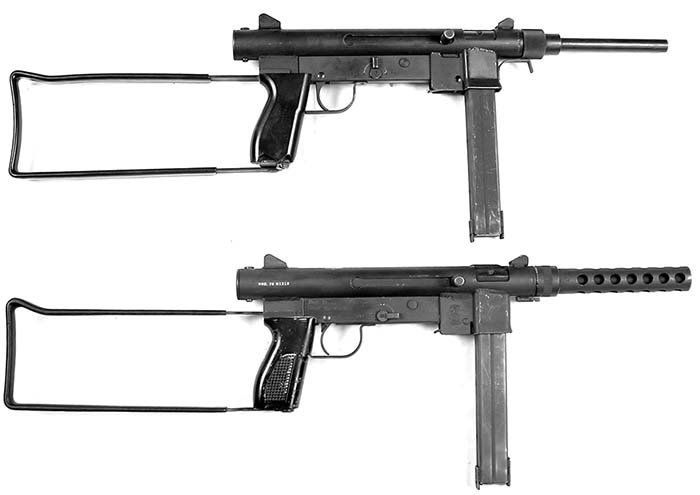
The buttstock folds and locks to the left side of the receiver as to not interfere with the cocking handle if the weapon is fired with the stock folded. The Smith & Wesson 76 is finished in a military-style, medium gray-green phosphate; the M76 has an overall length of 20.25 inches with the stock in the folded position. With the stock extended the length is 30.38 inches. Loaded weight with a 36-round magazine is 8.67 pounds.
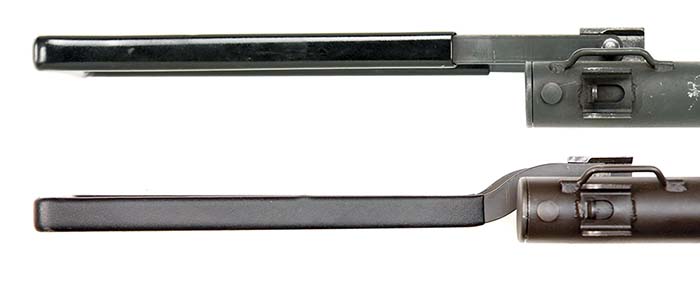
The first six production guns have unique serial numbers beginning with a letter “U” followed by six digits. These submachine guns were numbered U001001 through U001006. In June 1968, regular production began starting with serial number U101 until production ended with submachine gun serial U6100, built July 5, 1974.
The serial numbers of the production guns were marked on the right rear side of the receiver tube. There were a reported 6,000 production Model 76 weapons manufactured. A few minor variations appear in the production models. During 1969, the barrel jacket was changed from seamless tubing to a less expensive design made from a piece of flat sheet metal, which after cooling holes were punched into it, was rolled into a tube and welded along its seam. Another minor detail noted on some guns are two holes in the front of the magazine housing; the purpose of these holes is for a jig to hold the piece in place for a welding operation.
During July 1974, production of the Model 76 was terminated. The decision was made due to declining demand for pistol-caliber submachine guns, which were being replaced in law enforcement and military organizations by modern assault rifles.
The original retail cost of a Smith & Wesson Model 76 submachine gun in 1969 was $76.50. Today, all models of the Smith & Wesson M76 submachine guns are considered Curio & Relic firearms by the U.S. Bureau of Alcohol, Tobacco, Firearms and Explosives.
The United States Navy purchased a number of the Model 76 submachine guns and classified them: Navy Mark 24 Mod 0, NSN 1005-01-013-6050. Each of the weapons was issued with four magazines. The SEALs also requested that Smith & Wesson design a suppressor (silencer) for “their” Model 76s, to reduce the weapon’s report and muzzle flash. Smith & Wesson’s Dwayne Charron designed the Smith & Wesson M76 suppressor as a complete unit that would easily replace the weapon’s standard barrel.
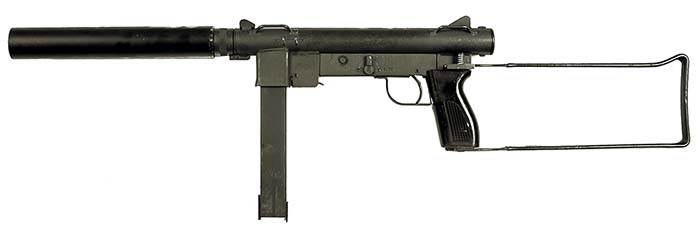
The barrel inside of the Smith & Wesson suppressor has a series of ports to reduce the velocity of standard 9mm ammunition to subsonic levels and to eliminate the sound generated when the bullet exceeds the speed of sound after leaving the barrel. Mr. Charron received patent number 3,713,362 on June 30, 1973, for his suppressor design. Production of the suppressors built by Smith & Wesson was limited to a few units.
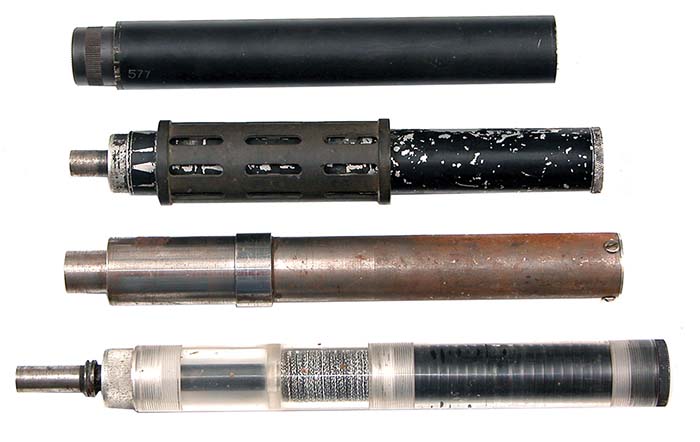
| This article first appeared in Small Arms Review V23N1 (January 2019) |










